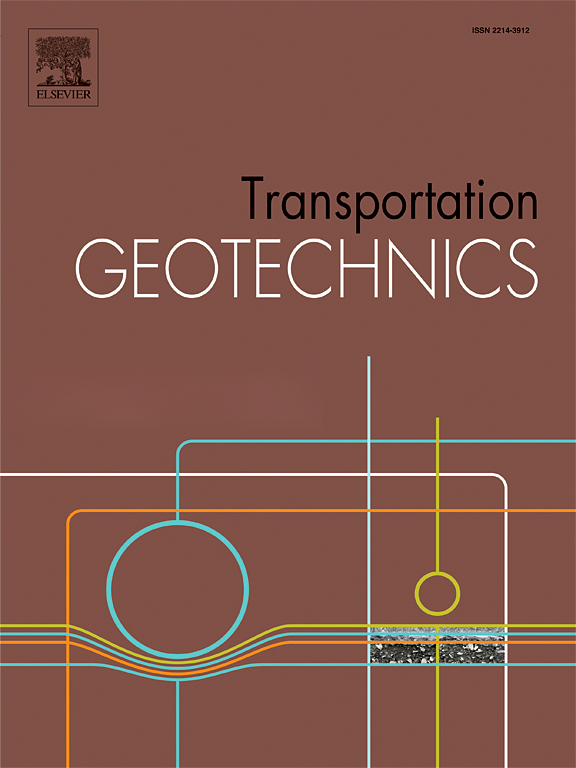Dynamic response of ballasted High-Speed Railways: insights from experimental measurements and 3D nonlinear numerical modelling
IF 4.9
2区 工程技术
Q1 ENGINEERING, CIVIL
引用次数: 0
Abstract
High-Speed Railways provide efficient transportation but impose significant dynamic forces on ballasted tracks, accelerating ballast degradation and increasing maintenance demands. This study aims to understand and mitigate these effects by investigating the dynamic behavior of ballasted tracks under high-speed train passages. A field campaign conducted on the Madrid-Barcelona high-speed line involved comprehensive instrumentation of the Brihuega railway segment to capture dynamic responses. These data were used to calibrate and validate an advanced three-dimensional numerical model incorporating nonlinear material properties and Coulomb friction interfaces in an innovative approach. The validated model accurately replicated vertical displacements and revealed that elastic deformations are primarily confined to the railpads and ballast layer, with minimal impact on deeper layers. Non-linear Coulomb friction modeling introduced in the ballast/sub-ballast interface enhanced stress transfer simulations, confirming negligible sliding between these two layers. Decreasing railpad stiffness from 100 to 60 kN/mm reduced ballast stresses by 10 % and improved load distribution, promoting longer track service life, while increasing rail displacements and reducing overall track stiffness by 20 %. This study concludes that railpad stiffness optimization can balance track resilience and degradation mitigation, providing a sustainable approach to infrastructure management. The validated numerical model offers a versatile tool for simulating complex track behaviors, enabling predictions of unmeasurable parameters like stress paths in the track bed. Future work should address long-term loading effects and non-uniform track conditions, advancing track design and maintenance strategies for high-speed rail networks.

有碴高速铁路的动态响应:来自实验测量和三维非线性数值模拟的见解
高速铁路提供了高效的运输,但对有碴轨道施加了巨大的动力,加速了砟层的退化,增加了维护需求。本研究旨在通过研究高速列车通道下有碴轨道的动力特性来了解和减轻这些影响。在马德里-巴塞罗那高速铁路上进行的实地考察包括对布里韦加铁路段进行综合仪器测量,以捕捉动态响应。这些数据被用来校准和验证一个先进的三维数值模型,该模型以一种创新的方式结合了非线性材料特性和库仑摩擦界面。经过验证的模型准确地复制了垂直位移,并显示弹性变形主要局限于轨道垫层和道砟层,对更深层的影响最小。在镇流器/副镇流器界面引入非线性库仑摩擦模型,增强了应力传递模拟,证实两层之间的滑动可以忽略不计。将轨道垫刚度从100 kN/mm降低到60 kN/mm,使道砟应力降低了10%,改善了负载分布,延长了轨道使用寿命,同时增加了轨道位移,使轨道总体刚度降低了20%。本研究得出结论,轨道垫刚度优化可以平衡轨道弹性和退化缓解,为基础设施管理提供可持续的方法。经过验证的数值模型为模拟复杂的轨道行为提供了一个通用的工具,可以预测轨道床中的应力路径等不可测量的参数。未来的工作应解决长期载荷效应和不均匀轨道条件,推进高速铁路网的轨道设计和维护策略。
本文章由计算机程序翻译,如有差异,请以英文原文为准。
求助全文
约1分钟内获得全文
求助全文
来源期刊

Transportation Geotechnics
Social Sciences-Transportation
CiteScore
8.10
自引率
11.30%
发文量
194
审稿时长
51 days
期刊介绍:
Transportation Geotechnics is a journal dedicated to publishing high-quality, theoretical, and applied papers that cover all facets of geotechnics for transportation infrastructure such as roads, highways, railways, underground railways, airfields, and waterways. The journal places a special emphasis on case studies that present original work relevant to the sustainable construction of transportation infrastructure. The scope of topics it addresses includes the geotechnical properties of geomaterials for sustainable and rational design and construction, the behavior of compacted and stabilized geomaterials, the use of geosynthetics and reinforcement in constructed layers and interlayers, ground improvement and slope stability for transportation infrastructures, compaction technology and management, maintenance technology, the impact of climate, embankments for highways and high-speed trains, transition zones, dredging, underwater geotechnics for infrastructure purposes, and the modeling of multi-layered structures and supporting ground under dynamic and repeated loads.
 求助内容:
求助内容: 应助结果提醒方式:
应助结果提醒方式:


